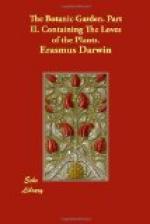A
thousand steely points on every scale
Form
the bright terrors of his bristly male.—
165 So arm’d, immortal Moore uncharm’d
the spell,
And
slew the wily dragon of the well.—
Sudden
with rage their injur’d bosoms burn,
Retort
the insult, or the wound return;
Unwrong’d,
as gentle as the breeze that sweeps
170 The unbending harvests or undimpled deeps,
They
guard, the Kings of Needwood’s wide domains,
Their
sister-wives and fair infantine trains;
Lead
the lone pilgrim through the trackless glade,
Or
guide in leafy wilds the wand’ring maid.
175 So WRIGHT’s bold pencil from Vesuvio’s
hight
Hurls
his red lavas to the troubled night;
From
Calpe starts the intolerable flash,
Skies
burst in flames, and blazing oceans dash;—
Or
bids in sweet repose his shades recede,
180 Winds the still vale, and slopes the velvet mead;
On
the pale stream expiring Zephyrs sink,
And
Moonlight sleeps upon its hoary brink.
Gigantic
Nymph! the fair KLEINHOVIA reigns,
The
grace and terror of Orixa’s plains;
[Hurls his red lavas. l. 176. Alluding to the grand paintings of the eruptions of Vesuvius, and of the destruction of the Spanish vessels before Gibraltar; and to the beautiful landscapes and moonlight scenes, by Mr. Wright of Derby.]
[Kleinhovia. l. 183. In this class the males in each flower are supported by the female. The name of the class may be translated “Viragoes,” or “Feminine Males.”
The largest tree perhaps in the world is of the same natural order as Kleinhovia, it is the Adansonia, or Ethiopian Sour-gourd, or African Calabash tree. Mr. Adanson says the diameter of the trunk frequently exceeds 25 feet, and the horizontal branches are from 45 to 55 feet long, and so large that each branch is equal to the largest trees of Europe. The breadth of the top is from 120 to 150 feet. And one of the roots bared only in part by the wasting away of the earth by the river, near which it grew, measured 110 feet long; and yet these stupendous trees never exceed 70 feet in height. Voyage to Senegal.]




